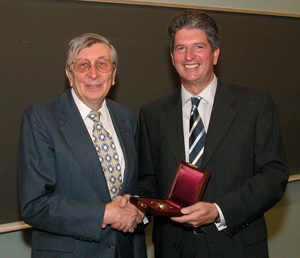|
10:55 a.m., April 29, 2003--Martin A. Green, an Australian professor who is playing a critical role in the development of solar cell technology, received the 2003 Karl W. Böer Solar Energy Medal of Merit at UD Monday, April 28.
 |
| Martin Green (right), University of New South Wales, Sydney, Australia, receives the 2003 Karl W. Böer Solar Energy Medal of Merit from the medal’s namesake, who founded UD’s Institute of Energy Conversion. |
Böer medal winners receive a bronze medal and $40,000. Green received the award from Karl Wolfgang Böer, the longtime UD faculty member it honors. UD President David P. Roselle presented Green with a check for a bit less than $40,000—because Australia and the U.S. do not have a reciprocal tax agreement.
Green is a pioneer in photovoltaics, the science of turning sunlight into electricity. He is Inaugural Scientia Professor at the Centre for Photovoltaic Engineering in Sydney, Australia, and foundation director for the Centre for Third Generation Photovoltaics at the University of New South Wales in Sydney.
Green’s research has dominated the development of improved silicon cells since 1983. His high-efficiency, low-cost solar cell has been licensed to many of the world’s largest manufacturers. With more than $100 million in sales, it is now the most successfully commercialized solar cell technology.
Green’s lab produced the innovative light-trapping solar cells that fuel the Honda Dream solar racing car and the cells that lit the outdoor areas at the 2000 Olympics in Sydney.
In beginning his award lecture, Green joked that his last name fit with his chosen career of “green energy’’ or solar power.
He told the audience the most economically feasible current use for solar energy is in countries such as Australia, where large areas are not electrified. He said costs would come down, though, if rooftop solar panels are installed more widely and if silicon wafer panels are replaced by new, less costly units.
Between 5,000 and 10,000 Australian homes now have rooftop solar energy installations, Green said, and Germany and Japan each boast at least 100,000 solar-equipped homes.
Green received wide applause when he announced he will use his award money to fund the installation of solar technology in Nicaragua, which has one of the lowest electrification rates in the world.
The Böer medal has been presented biannually since 1993 when former U.S. President Jimmy Carter was the first recipient. Carter was cited for focusing world attention on solar energy.
Article by Kathy Canavan
Photo by Duane Perry
|

